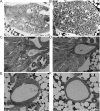A combined approach to heat stress effect on male fertility in Nasonia vitripennis: from the physiological consequences on spermatogenesis to the reproductive adjustment of females mated with stressed males
- PMID: 25807005
- PMCID: PMC4373853
- DOI: 10.1371/journal.pone.0120656
A combined approach to heat stress effect on male fertility in Nasonia vitripennis: from the physiological consequences on spermatogenesis to the reproductive adjustment of females mated with stressed males
Abstract
In recent years, several studies have shown a decline in reproductive success in males in both humans and wildlife. Research on male fertility has largely focused on vertebrates, although invertebrates constitute the vast majority of terrestrial biodiversity. The reduction of their reproductive capacities due to environmental stresses can have strong negative ecological impacts, and also dramatic consequences on world food production if it affects the reproductive success of biological control agents, such as parasitic wasps used to control crop pests. Here Nasonia vitripennis, a parasitic wasp of various fly species, was studied to test the effects of 24h-heat stress applied during the first pupal stage on male fertility. Results showed that only primary spermatocytes were present at the first pupal stage in all cysts of the testes. Heat stress caused a delay in spermatogenesis during development and a significant decrease in sperm stock at emergence. Females mated with these heat-stressed males showed a reduce sperm count stored in their spermatheca. Females did not appear to distinguish heat-stressed from control males and did not remate more frequently to compensate for the lack of sperm transferred. As a result, females mated with heat-stressed males produced a suboptimal lifetime offspring sex ratio compared to those mated with control males. This could further impact the population dynamics of this species. N. vitripennis appears to be an interesting biological model to study the mechanisms of subfertility and its consequence on female reproductive strategies and provides new research perspectives in both invertebrates and vertebrates.
Conflict of interest statement
Figures






Similar articles
-
Sperm limitation affects sex allocation in a parasitoid wasp Nasonia vitripennis.Insect Sci. 2019 Oct;26(5):853-862. doi: 10.1111/1744-7917.12586. Epub 2018 May 10. Insect Sci. 2019. PMID: 29521468
-
Heat shock sensitivity of adult male fertility in the parasitoid wasp Anisopteromalus calandrae (Hymenoptera, Pteromalidae).J Therm Biol. 2019 Oct;85:102419. doi: 10.1016/j.jtherbio.2019.102419. Epub 2019 Sep 17. J Therm Biol. 2019. PMID: 31657760
-
The spatio-temporal partitioning of sperm by males of the prospermatogenic parasitoid Nasonia vitripennis is in line with its gregarious lifestyle.J Insect Physiol. 2016 Aug-Sep;91-92:10-7. doi: 10.1016/j.jinsphys.2016.06.002. Epub 2016 Jun 3. J Insect Physiol. 2016. PMID: 27269614
-
[Parasitic wasps, a model for studying male subfertility].Med Sci (Paris). 2012 Jan;28(1):76-81. doi: 10.1051/medsci/2012281020. Epub 2012 Jan 27. Med Sci (Paris). 2012. PMID: 22289834 Review. French.
-
Fertility and Sperm Quality in the Aging Male.Curr Pharm Des. 2017 Nov 28;23(30):4429-4437. doi: 10.2174/1381612823666170503150313. Curr Pharm Des. 2017. PMID: 28472913 Review.
Cited by
-
Fertility loss and recovery dynamics after repeated heat stress across life stages in male Drosophila melanogaster: patterns and processes.R Soc Open Sci. 2024 Oct 2;11(10):241082. doi: 10.1098/rsos.241082. eCollection 2024 Oct. R Soc Open Sci. 2024. PMID: 39359471 Free PMC article.
-
Unveiling Molecular Effects of the Secondary Metabolite 2-Dodecanone in the Model Hymenopteran Nasonia vitripennis.Toxics. 2024 Feb 18;12(2):159. doi: 10.3390/toxics12020159. Toxics. 2024. PMID: 38393254 Free PMC article.
-
The Effects of Temperature on the Development, Morphology, and Fecundity of Aenasius bambawalei (=Aenasius arizonensis).Insects. 2021 Sep 16;12(9):833. doi: 10.3390/insects12090833. Insects. 2021. PMID: 34564272 Free PMC article.
-
Sperm Production Is Reduced after a Heatwave at the Pupal Stage in the Males of the Parasitoid Wasp Microplitisrufiventris Kok (Hymenoptera; Braconidae).Insects. 2021 Sep 23;12(10):862. doi: 10.3390/insects12100862. Insects. 2021. PMID: 34680631 Free PMC article.
-
How development and survival combine to determine the thermal sensitivity of insects.PLoS One. 2024 Jan 30;19(1):e0291393. doi: 10.1371/journal.pone.0291393. eCollection 2024. PLoS One. 2024. PMID: 38289939 Free PMC article.
References
-
- Stearns SC. The evolution of life histories: Oxford University Press; 1992.
-
- Rohmer C, David JR, Moreteau B, Joly D. Heat induced male sterility in Drosophila melanogaster: adaptive genetic variations among geographic populations and role of the Y chromosome. J Exp Biol. 2004; 207: 2735–2743. - PubMed
-
- David J, Araripe L, Chakir M, Legout H, Lemos B, Petavy G, et al. Male sterility at extreme temperatures: a significant but neglected phenomenon for understanding Drosophila climatic adaptations. J Evolution Biol. 2005; 18: 838–846. - PubMed
Publication types
MeSH terms
Substances
LinkOut - more resources
Full Text Sources
Other Literature Sources
Medical
Research Materials

